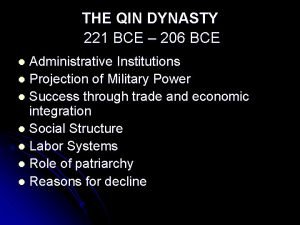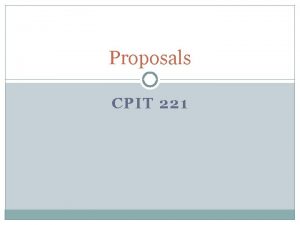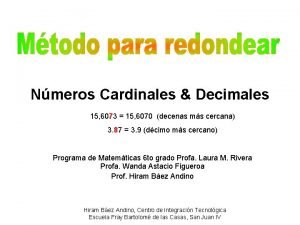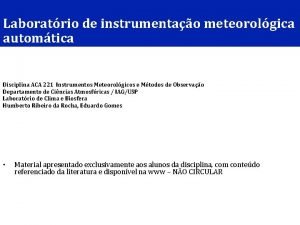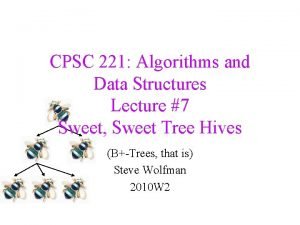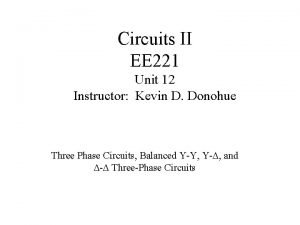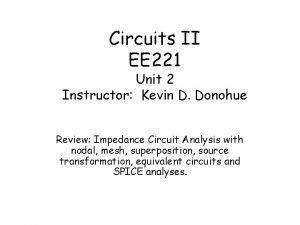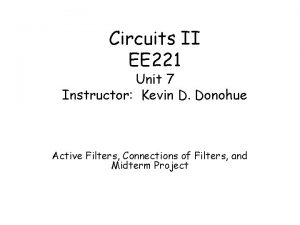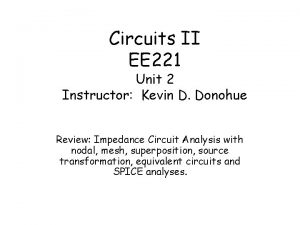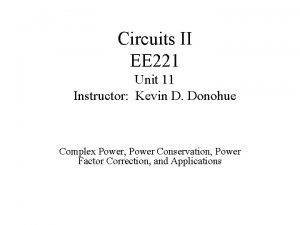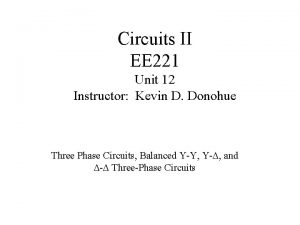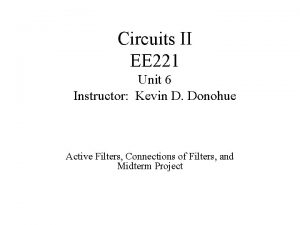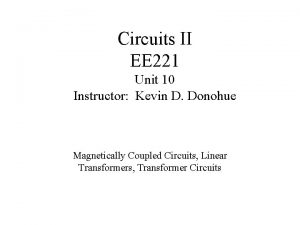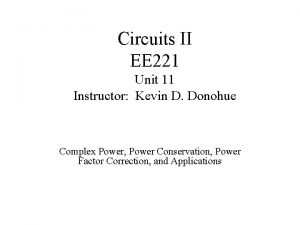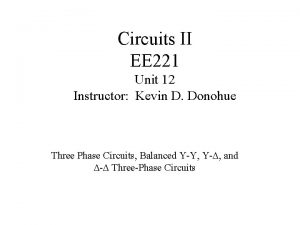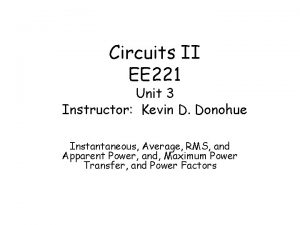Circuits II EE 221 Unit 8 Instructor Kevin


















- Slides: 18

Circuits II EE 221 Unit 8 Instructor: Kevin D. Donohue 2 Port Networks –Impedance/Admittance, Transmission, and Hybird Parameters

2 -Port Circuits Ø Ø Network parameters characterize linear circuits that have both input and output terminals, in terms of linear equations that describe the voltage and current relationships at those terminals. This model provides critical information for understanding the effects of connecting circuits, loads, and sources together at the input and output terminals of a twoport circuit. A similar model was used when dealing with oneport circuits. Review example: Thévenin and Norton Equivalent Circuits: Show that Voc=8 V, Isc = 0. 08 A, and Rth = 100

2 -Port Circuits: Now take away the source from the previous example: Ø Ø Ø Why wouldn't it make sense to talk about a Thévenin or Norton equivalent circuit in this case? The Thévenin and Norton models must be extended to describe circuit behavior at two ports. Label the terminal voltage and currents as v 1, i 1, v 2, and i 2 and develop a mathematical relationship to show their dependencies.

Inverse Transmission -Parameter Model: If the circuit is linear, then a general linear relationship between the terminal voltages and currents can be expressed as: Ø Ø Geometrically each equation forms a planar surface over the v 1 -i 1 plane, therefore, only three non-colinear points on the surface are necessary to uniquely determine a, b, c, d, V 2, and I 2. So if the circuit response is known for three different values of the v 1 -i 1 pairs, six equations with six unknowns can be generated and solved. This problem can be simplified by strategically setting v 1 and i 1 to zero in order to isolate unknown parameters and simplify the resulting equations. In general, if no independent sources exist in the circuit, then V 2 and I 2 will be 0. This will be the case for the problems considered in this unit.

Example Determine the inverse transmission parameter model for the given circuit. Show that a =18/5, b= 100 , c = 7/250 Siemens, d= 1.

Summary Formula for Inverse Transmission Parameters: Ø If all independent sources are deactivated, set i 1 = 0 to find: Ø If all independent sources are deactivated, set v 1 = 0 to find:

Equivalent Circuit for Inverse Transmission Parameter Model: If inverse transmission parameters are known, then the following circuit can be used as an equivalent circuit: This circuit is helpful when implementing in SPICE without knowledge or details of circuit from which parameters were derived.

SPICE Solutions for Two-Port Parameters: By strategically selecting the constraints on port variables, the two-port parameters are the ratios of other port variables. Therefore: Ø Ø Ø Port variables can be constrained by attaching a zero-valued voltage or current source. The other port can be excited by a unity-valued source (or some other convenient value). Place meters at remaining ports to obtain values for evaluating ratios. The two-port parameter can be found from values determined through SPICE. Example: Determine the SPICE commands to find the abcd parameters for the circuit below.

SPICE Solutions for Two-Port Parameters: 1) Consider setting v 1=0, then 2) Excite the circuit with i 2=1 then 3) Use SPICE to compute v 2 and i 1 to solve for b and d.

SPICE Solutions for Two-Port Parameters: 4) Consider setting i 1=0, then 5) Excite the circuit with v 2=1, then 6) Use SPICE compute v 1 and i 2 to solve for a and c.

Transmission -Parameter Model: Transmission parameters are related to the inverse transmission parameters by reversing the independent and dependent variables: Transmission Parameters Inverse Transmission Parameters

Impedance/Admittance-Parameter Model: Impedance Parameters Admittance Parameters

Hybrid (h)/Inverse Hybrid (g)-Parameter Model: Hybrid Parameters Inverse Hybrid Parameters

Relationship Between 2 Sets of Port Parameters: Since a single set of network parameters characterize the linear circuits completely at the input and output terminals, it is possible to derive other network parameters from this set. Example: Consider the z and y parameter characterization of a given circuit with no independent sources: Show that:

Relationship Between 2 Sets of Port Parameters: Example: Consider the abcd and h parameter characterization of a given circuit with no independent sources: Show that:

Terminal Currents and Voltages from Port Parameters: Once the port parameters are known, no other information from the circuit is required to determine the behavior of the currents and voltages at the terminals. Example: Given the z-parameter representation of a circuit, determine the resulting terminal voltages and currents when a practical source with internal resistance Rs and voltage Vs is connected to the input (terminal 1) and a load RL is connected to the output (terminal 2): Show that:

Combinations of Two-Port Networks: Consider circuits A and B described by their abcdparameters (assume independent sources zero). If A and B are connected in series, show that the abcd parameters for the new two-port (from v 1 a to v 2 b) is given by:

Combinations of Two-Port Networks: Consider circuits A and B described by their y-parameters (assume independent sources zero). If A and B are connected in parallel, show that the yparameters for the new two-port (from v 1 a to v 2 b) is given by:











